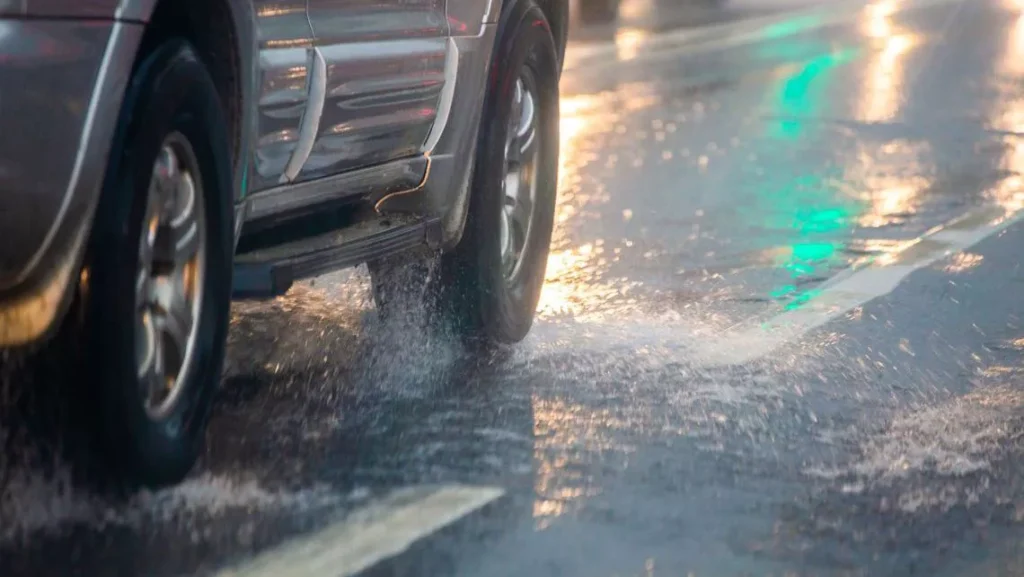Hydroplaning or aquaplaning on roads is known as dangerous situations when a vehicle tire can lose contact with road due to the water layer, and the consequence is loss of vehicle control, steering control, braking, and traction, as a result in slipping, skidding, jackknifing of heavy and long vehicles, rollover and property damage, accident, injury, or fatalities.
Why does hydroplaning or Aquaplaning happen on the road?
There are several factors for hydroplaning or aquaplaning :
- Speed is the cause of hydroplaning and aquaplaning: speed of 40 kmph in heavy rain, water lodging areas, and wet surface roads can cause hydroplaning or aquaplaning.
- Tire Condition: Tire grip do vital road on road. Worn-out or low-grip tires reduce a vehicle’s low traction on the road. Tire Low tread depth cannot disperse water properly and increases the risk of hydroplaning.
- Water Depth: A thin layer of water or accumulated water on a road is enough to cause hydroplaning. Even <2.5 mm of water on the road is a hazard for all road users and a cause of risk factors.
- Road Condition: in Indian Road is maximum tar and RCC road, that is for smooth driving at curving road and low dip road, there is chance of water accumulation during rain, and they are not adequately maintained or designed to drain the water properly.
- Vehicle Weight: Lower weight, higher chance Higher weight lower chance of hydroplaning. due to low or higher force on the tires. Lighter vehicles have a higher chance of hydroplanning because they don’t have enough weight to break the water layer.
- Driving manoeuvres: harsh braking, quick lane change, quick turns, or rapid acceleration can increase the hydroplaning at the water lodging area.
Result of Hydroplaning or Aquaplaning :
- If a vehicle hydroplanes, the driver will lose control of steering, braking, and acceleration. This can lead to skidding, spinning, or sliding sideways. or off the track and incident.
- Increased Stopping Distance: The stopping distance will increase due to the hydroplaning and low traction on the road. which leads to rear-end collisions or running off the road, jackknifing, and slipping on the road, especially for TW riders.
- Collision Risk: Loss of control increases the collisions with other vehicles, dividers, traffic police control barriers, and adjacent shops due to hydroplaning on the road.
- Vehicle Damage: Hydroplaning can cause vehicle damage, including bumper damage, tire blowouts, and suspension damage. It may also lead to other mechanical issues. Injury, fatality, or property damage from rollovers is also a risk.
How to Prevent skidding on the Road? :
- Stay Clam
- Maintain proper tire pressure and adequate tread depth > 1.6 mm.
- Drive below 20 to 40 kmph: low speed, low risk; high speed, high risk.
- Avoid sudden manoeuvres, accelerations, or harsh steering.
- Stick to the left to middle lanes where the chance of water lodging is at both edges of the road.
- Maintain following Distance at least 3 sec gap from the front running vehicle
- Avoid harsh braking.
- Keep the steering wheel straight.
Also Read : –Slow or Speed Driving on Indian Road
Conclusion :
- Aquaplaning or hydroplaning is a serious hazard on wet roads. It can lead to loss of control, collisions, injuries, and fatalities. Always drive carefully in wet conditions. Keep your tires in good condition with proper tire pressure. Drive carefully on wet and waterlogged roads to stay safe.


Pingback: Unexpected Road Experience from Lucknow to Ayodhya @India - Safe Road Life